Abstract
Amur honeysuckle (Lonicera maackii (Rupr.) Herder) and wintercreeper (Euonymus fortunei (Turcz.) Hand.-Maz.) are important invasive plants in Midwestern U.S. forests. We studied how two herbicides at two concentrations combined with three concentrations of a surfactant affected the mortality of these species. For L. maackii, we also studied the effect of application timing, and for E. fortunei, we also measured the treatment effect on native species after one year. For E. fortunei, triclopyr caused complete mortality at both low and high concentrations. The application of glyphosate increased mortality from low to high concentrations. The addition of a surfactant to glyphosate increased mortality, with the low concentration being as effective as the high concentration. There was a negative effect of surfactant on native species, with the high concentration of the surfactant causing a 75% reduction in native species compared to not using a surfactant. For L. maackii, there was greater mortality from the fall application of herbicides. Mortality was higher overall with the addition of a surfactant, but the effect of the surfactant was more important in spring. Glyphosate was more effective in fall, while triclopyr tended to be more effective in spring. Generally, lower concentrations of herbicides tended to have a higher efficacy in the fall. Our results can help managers determine the best method of chemical control that balances cost, efficacy, and recovery of native species.
1. Introduction
Invasive species have negative ecological and economic impacts on environments throughout the world [1]. In forests, invasive species can affect tree growth and regeneration [2] and reduce tree seedling diversity and abundance [3]. Invasive species occupy ~7% of forest areas in the Southern U.S., with over half of invasive species cover consisting of woody vines [4]. Because of their numerous impacts, forest managers seek methods to control invaders effectively in a cost-effective manner [5]. The removal of invasive species can prevent the local extinction of competing native plant species [6]. Estimates suggest that USD 46 billion has been spent on management over the past 60 years [7]. After removal of the invasive species, additional restoration activities are usually required to recover the native plant community after invasion [8].
Euonymus fortunei (Turcz.) Hand.-Maz. (Celastraceae), or wintercreeper, is a woody evergreen climbing vine or trailing shrub native to China. This species has invaded forests in the eastern half of the United States [9] after its introduction as an ornamental species through both vegetative spread and seeds that are dispersed by birds [10]. The impacts of E. fortunei have, in general, been rarely examined, but one study showed that native plant diversity increases after its removal [11]. It forms dense mats on the ground in the areas that it invades [12] and it can also climb and overwhelm standing trees. It has been shown to change soil conditions [13] that may promote its own growth over native species [14,15].
Lonicera maackii (Rupr.) Herder (Caprifoliaceae), or Amur honeysuckle, is a large shrub that was imported from China as an ornamental species. It is a vigorous invader of old fields, as well as forest edges and interiors, and it is found in most of the eastern U.S. [9,16,17]. Its seeds can be dispersed by birds [18] and deer [19]. Its direct and indirect effects on native ecosystems are well-documented [20]. For example, native plant richness is reduced below the canopy of L. maackii [21]. It can allelochemically inhibit the germination of native species [22,23]. Forest stands invaded by L. maackii show a reduction in tree basal area growth [24], and its presence lowers tree seedling survival [25,26]. It also has indirect negative effects; for example, shading by L. maackii can reduce the pollination of an understory herb [27]. It can also affect neighboring plant species by allelopathically reducing mycorrhizal inoculation [28].
The presence of L. maackii not only affects plants but can also have impacts throughout the ecosystem. It can affect the diversity and composition of forest floor amphibians [29], bird nesting success [30,31], and nutrient cycling [32]. Lonicera maackii can also affect aquatic systems in invaded forests. Nutrient dynamics and species composition are impacted in invaded watersheds [33]. The presence of L. maackii foliage in aquatic mosquito habitats facilitates an invasive mosquito [34]. Such impacts on plants and other parts of forest ecosystems make L. maackii a common target for control efforts.
The methods used to control woody invasive species can be mechanical, including hand removal, mowing, mulching, tilling, and cutting [35]. Fire has been used, but many of these attempts lead to the regrowth of invasive species and damage to native species [36]. There is also chemical control, using herbicides such as glyphosate, triclopyr, imazapyr, and metsulfuron [37,38]. Herbicides can be applied in several ways, including foliar sprays [39], direct application to cut stems, i.e., the “cut-and-paint” method [25], and the application of a high concentration of herbicide to the bark at the base of the plant, i.e., the “basal bark” method [40].
Two commonly used herbicides for invasive species control are glyphosate and triclopyr. Glyphosate is a non-specific systemic herbicide; it is the most widely used herbicide globally [41] and the most used herbicide for invasive species control in North America [42]. Glyphosate blocks the activity of an enzyme that catalyzes the sixth step in the shikimic acid pathway, preventing the synthesis of aromatic amino acids, with the death of the plant within 1–3 weeks [43]. Its residence time in soil is a few days to a few months [44,45]. Triclopyr is a broadleaf specific systemic herbicide that is commonly used in invasive species control [46]. Triclopyr mimics the plant hormone auxin and disrupts the natural signaling and degradation in the auxin pathway, leading to uncontrolled growth and eventual death [47]. The half-life of triclopyr in soil ranges from a few days to six weeks [48,49]. Surfactants are frequently used with herbicides to reduce surface tension and increase permeability across plant cuticles [50], and they may allow for the use of lower concentrations of herbicides [51,52]. The effectiveness of an herbicide can vary with the concentration of the surfactant [53] and with the amount of cuticular wax [54]. Season of application may affect herbicide effectiveness; the application of triclopyr during the early spring was more effective than during the summer [46]. Any time herbicides are used, there is a potential for non-target effects [40,49,55] that must also be considered.
The current management of E. fortunei consists of chemical and mechanical methods. Small infestations allow for mechanical control such as pulling, but this method becomes too labor-intensive once larger populations are established. The cut-and-paint and foliar spray methods are also effective [12,56]. There are some concerns about the adequate penetration of herbicide through the thick cuticular wax on the stems and leaves, which can be mitigated using a surfactant or other adjuvant. A 3.2% solution of glyphosate applied with a surfactant seed oil during two mid-summer foliar applications was necessary to achieve complete defoliation for E. fortunei [55]. The foliar application of 2% glyphosate or 2.5% triclopyr with surfactant during the dormant season effectively controlled E. fortunei [12].
Lonicera maackii is commonly managed using foliar spray, cut-and-paint, and basal bark treatments. Mechanical methods such as using a forestry mulcher head have also been used with success, but they are very destructive [57]. Foliar spray with 1% glyphosate kills ~80% of plants [58], and cut-and-paint is also highly effective on Lonicera species [59]. Basal bark application requires less effort than the cut-and-paint method and has fewer non-target impacts than has been found with foliar spraying [60], but it requires higher herbicide concentrations. The basal bark treatment of L. maackii with 17% triclopyr led to complete mortality for a range of stem diameters [61]. Basal bark application with triclopyr was effective and, importantly, did not affect soil communities [62]. The basal bark and foliar spray methods have the advantage of leaving the dead stems standing, which can help protect planted or regenerating species against herbivory by deer [63].
We aimed to determine the best combination of herbicide type, herbicide concentration, and surfactant concentration to kill E. fortunei and L. maackii, with the goal of determining the most cost-effective method to control each of these species. Previous research in this area has not used a wide range of these variables in a comparative full-factorial design. For L. maackii, we also compared the success of spring versus fall applications, and for E. fortunei, we also studied the abundance of native species one year after treatment. Finally, we calculated the cost of each of our treatment combinations for use in budgetary decisions.
2. Materials and Methods
2.1. Study Site and Experimental Design
All experiments were conducted in 2009 and 2010 at Winton Woods (39.258382, −84.518275) in the Hamilton County Park District of Cincinnati, Ohio. The site is a secondary growth deciduous mixed-hardwood forest embedded in a suburban landscape. A full-factorial experiment with the factors of type of herbicide (glyphosate or triclopyr), concentration of herbicide (high or low), and concentration of surfactant (zero, low, or high) was used. Treatments were applied in fall for Euonymus fortunei and in fall and spring for Lonicera maackii. The two herbicides used were glyphosate (AquaNeat, 53.8% glyphosate, Nufarm Americas Inc., Alsip, IL, USA) and triclopyr (Garlon 3A, 44.4% triclopyr, Dow AgroSciences LLC., Indianapolis, IN, USA). These herbicides are readily available without a license and are frequently used by managers to control invasive plant species. Surfactants are recommended to be used with both herbicides in terrestrial settings. The surfactant (Pentrabark, 99.8% active ingredients, Quest Product Corp., Linwood, KS, USA) was applied at zero, low (1.7% active ingredients), and high (3.6% active ingredients) concentrations. The manufacturer-recommended amount for bark application is 1.5%–2.5% active ingredients. Control plots for E. fortunei and control stems for L. maackii (water-only control) were not included in our analyses, as no mortality was observed in the controls during our study. Further, the removal of these plots allowed for the use of a full-factorial model during the data analysis to better consider the interactions between treatments. All statistical analyses were completed using Minitab 16 (Minitab LLC, State College, PA, USA).
2.2. Control of Euonymus fortunei
We identified an area that was uniformly and densely invaded by E. fortunei. On 13 September 2010, 36 1-m2 patches of E. fortunei were treated with foliar sprays of herbicide. We used two concentrations of each herbicide type (glyphosate at 1.3% and 2.7% active ingredient; triclopyr at 1.7% and 3.3% active ingredient) with varying levels of surfactant (zero, low, or high). These concentrations are within the range of concentrations commonly used in practice [12,55]. Treatments were applied in a full-factorial design in 1 m2 plots, separated by at least 1 m, with three replicates per treatment combination. The plots were sprayed on a warm (~26 °C), sunny day using an herbicide tank sprayer to cover the entire plot until the leaves were fully saturated. There was no rain for at least 24 h after the application. Three control plots that were treated with water spray only were also monitored. A 91-cm-diameter ring was placed in the center of each plot within which to collect data. On 15 May 2011, the percent cover of E. fortunei in each plot was measured to assess the percent mortality. On 9 August, 2011, the number and identity of native herbs, vines, and tree seedlings in each plot were measured.
Since the mortality of E. fortunei was 100% for all treatment combinations with triclopyr, the triclopyr concentration was not analyzed statistically for its effects on E. fortunei. For treatments with glyphosate, the independent and interactive effects of the glyphosate concentration and surfactant concentration on the percent mortality of E. fortunei were analyzed using ANOVA. The independent and interactive effects of herbicide type, herbicide concentration, and surfactant concentration on the total number of native species were analyzed using ANOVA. Data were square-root-transformed to meet the model assumptions. Tukey’s tests at α = 0.05 were performed to determine significant differences between treatments when significance was found in the ANOVA.
2.3. Control of Lonicera maackii
We identified an area heavily invaded by L. maackii and selected 72 shrubs of similar size (~2 m tall) to treat. We applied the herbicide/surfactant mixtures using the basal bark method, spraying the bark of all stems on each shrub until full saturation of the bottom ~20 cm of the stems was reached. We applied the treatments on warm, sunny days on half of the shrubs on 5 September 2009 (fall, ~27 °C) and the other half on 10 April 2010 (spring, ~22 °C). There was no rain for at least 24 h after the application. We applied two concentrations for each herbicide (glyphosate at 8.8% and 20.2% active ingredient; triclopyr at 11.1% and 14.6% active ingredient) and three concentrations of surfactant at two different times, in a full-factorial experiment with treatment combinations replicated 3 times. These concentrations are within the range of concentrations commonly used in practice [61,62]. Three shrubs that were treated with water spray only were also monitored. The treated shrubs were assessed for mortality on 10 September, 2010 and were considered dead if they had no green leaves.
The proportion of shrubs killed in each treatment combination was compared using a full-factorial ANOVA with the fixed factors of season, herbicide type, herbicide concentration, and surfactant concentration. Data were arcsin-square-root-transformed to meet the model assumptions of normality. Tukey’s tests at α = 0.05 were performed to determine significant differences between treatments when significance was found in the ANOVA.
2.4. Cost of Herbicide Application
The costs of each herbicide treatment were determined by finding the currently commercially available price for each herbicide and the surfactant and then determining the cost per L to make each treatment solution for E. fortunei and for L. maackii.
3. Results
3.1. Control of Euonymus fortunei
Untreated control plots maintained 90-100% cover of E. fortunei. Complete mortality occurred for all E. fortunei plots treated with triclopyr. Glyphosate had a significant effect on E. fortunei (F1,12 = 13.01, p = 0.004), increasing mortality with an increase in concentration (Figure 1). In glyphosate-containing treatments, surfactant concentration significantly affected the mortality of E. fortunei, with low concentrations of surfactant increasing mortality compared to the zero concentration, and high concentrations of surfactant having intermediate effects between the two (F2,12 = 5.31, p = 0.022; Figure 2).
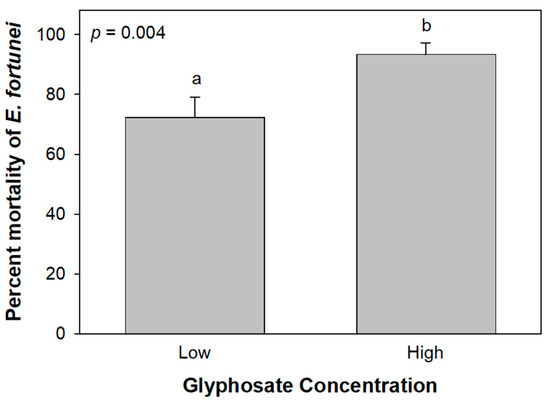
Figure 1.
Mean percent mortality (±SE) of E. fortunei for two concentrations of glyphosate (low = 1.3%; high = 2.7%) across all surfactant treatments. Means with different letters are significantly different at α = 0.05.
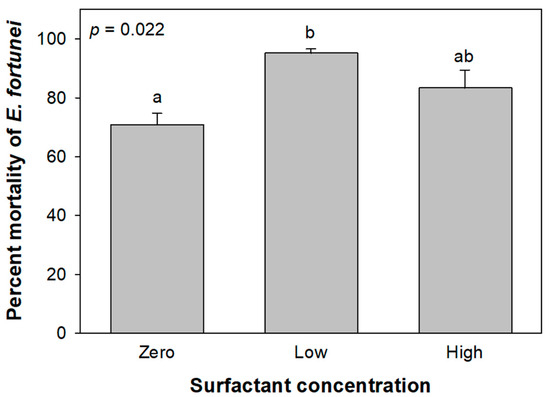
Figure 2.
Mean percent mortality (±SE) of E. fortunei for three concentrations of surfactant (low = 1.7% active ingredients; high = 3.6% active ingredients) across all herbicide treatments. Means with the same letters are not significantly different according to Tukey’s test at α = 0.05.
Native species that were found in the experiment plots one year after treatment included Virginia creeper (Parthenocissus quinquefolia (L.) Planch), jewelweed (Impatiens capensis Meerb.), tuliptree (Liriodendron tulipifera L.), black cherry (Prunus serotina Ehrh.), and red maple (Acer rubrum L.). The number of native species in the plots was affected by the surfactant concentration (F2,24 = 3.80, p = 0.037) and the interaction between herbicide type and concentration (F1,24 = 4.67, p = 0.041). Across herbicide types, increasing concentrations of surfactant negatively affected the numbers of native species, with significant differences between no and high surfactant (Figure 3). Across surfactant treatments, the high concentration of glyphosate led to increased native species richness compared to the low concentration, while triclopyr had the opposite effect (Figure 4). There was a nearly significant effect of the interaction of herbicide type, herbicide concentration, and surfactant concentration (F2,24 = 3.24, p = 0.057, Figure 5). Untreated control plots had on average less than one plant per plot (0.67 ± 0.33).
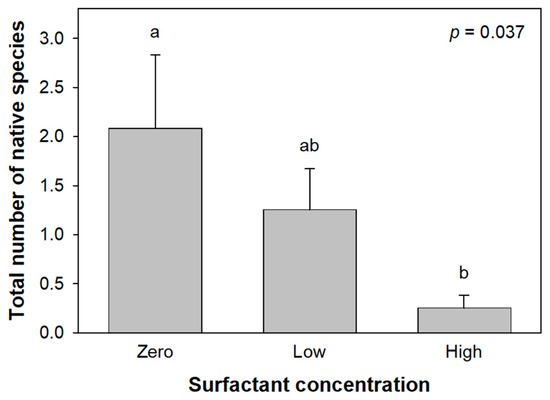
Figure 3.
Mean number (±SE) of native species in plots for three concentrations of surfactant (low = 1.7% active ingredients; high = 3.6% active ingredients) across all herbicide treatments. Means with the same letters are not significantly different according to Tukey’s test at α = 0.05.
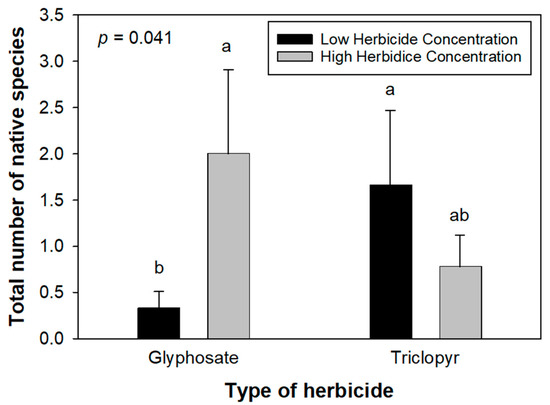
Figure 4.
Mean number (±SE) of native species for two concentrations (% active ingredients: low glyphosate = 1.3% and high glyphosate = 2.7%; low triclopyr = 1.7% and high triclopyr = 3.3%) of two herbicides across all surfactant treatments. Means with the same letters are not significantly different according to Tukey’s test at α = 0.05.
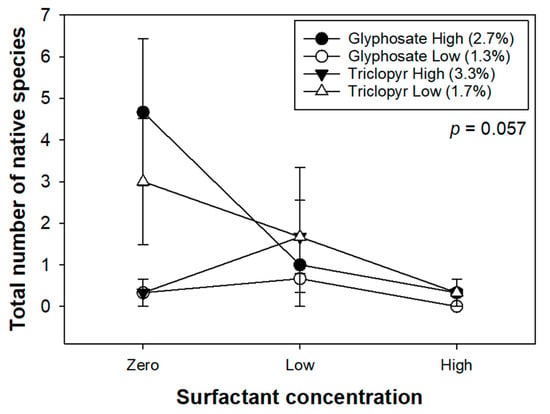
Figure 5.
Mean number (±SE) of native species for two concentrations of two herbicides and three concentrations of surfactant (low = 1.7% active ingredients; high = 3.6% active ingredients).
3.2. Control of Lonicera maackii
There was an overall significant effect of season (F1,47 = 4.69, p = 0.037) on L. maackii mortality, with greater mortality after the fall treatments than after the spring treatments (Figure 6). There was a significant effect of surfactant concentration across herbicide treatments (F2,47 = 4.81, p = 0.013; Figure 7), with mortality higher overall with the addition of surfactant. The effect of surfactant varied with season (F2,47 = 3.38, p = 0.042; Figure 8), with the addition of surfactant being more important in spring. The interaction of herbicide concentration and season approached significance (F1,47 = 3.99, p = 0.052; Figure 9), with lower concentrations having higher efficacy in fall. Mortality was high in fall even without the addition of surfactant. The effectiveness of each type of herbicide varied with season (F1,47 = 26.29, p < 0.001; Figure 10), with glyphosate tending to being more effective in fall and triclopyr being more effective in spring.
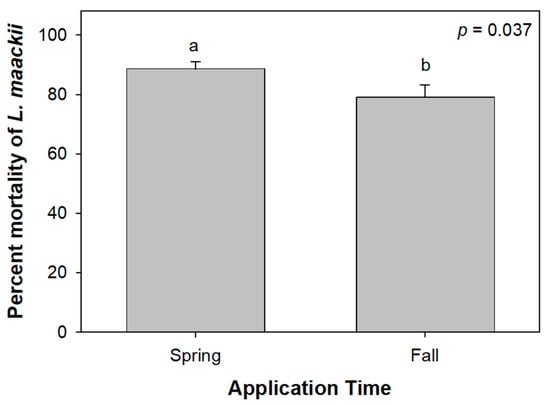
Figure 6.
Mean percent mortality (±SE) of L. maackii shrubs for two application times across all surfactant and herbicide treatments. Means with the same letters are not significantly different according to Tukey’s test at α = 0.05.
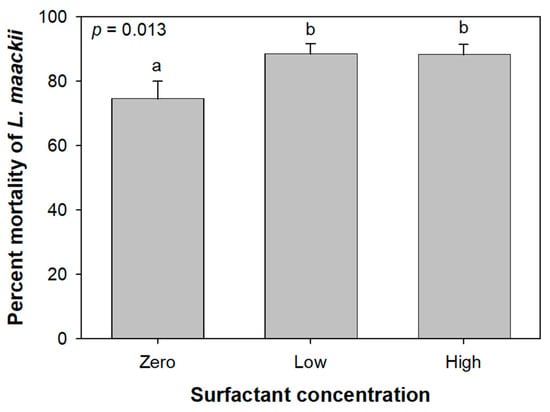
Figure 7.
Mean percent mortality (±SE) of L. maackii shrubs for three concentrations of surfactant (low = 1.7% active ingredients; high = 3.6% active ingredients) across all herbicide treatments. Means with the same letters are not significantly different according to Tukey’s test at α = 0.05.
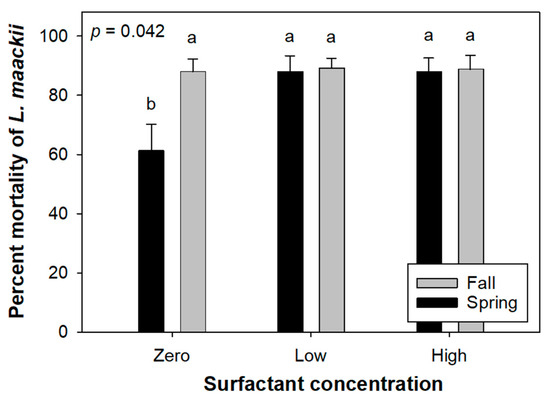
Figure 8.
Mean percent mortality (±SE) of L. maackii shrubs for three concentrations of surfactant (low = 19.5 ml/L; high = 3.6% active ingredients) in two application seasons across all herbicide treatments. Means with the same letters are not significantly different according to Tukey’s test at α = 0.05.
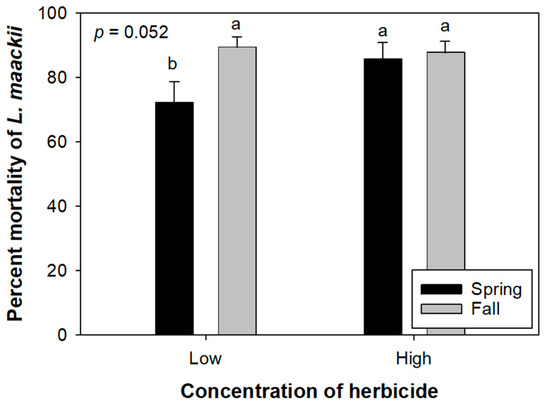
Figure 9.
Mean percent mortality (±SE) of L. maackii shrubs for low and high concentrations of herbicides (% active ingredients: low glyphosate = 8.8% and high glyphosate = 20.2%; low triclopyr = 11.1% and high triclopyr = 14.6%) in two application seasons across herbicide types. Means with the same letters are not significantly different according to Tukey’s test at α = 0.05.
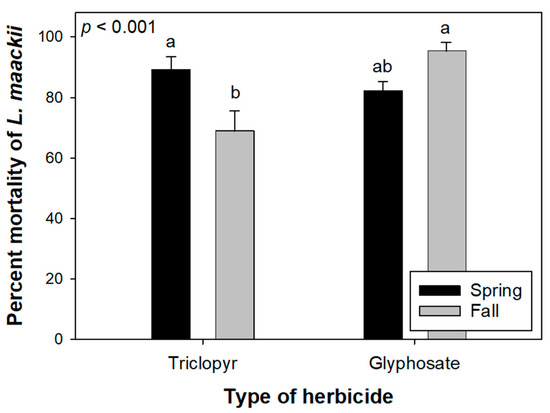
Figure 10.
Mean percent mortality (±SE) of L. maackii shrubs for two different herbicides in two application seasons across surfactant treatments. Means with the same letters are not significantly different according to Tukey’s test at α = 0.05.
3.3. Cost of Herbicide Application
The cost of each treatment combination for each experiment is detailed in Table 1.

Table 1.
Cost in USD for each treatment combination per liter of herbicide solution for Euonymus fortunei foliar application and Lonicera maackii basal bark application. Concentrations of the surfactant Pentrabark were zero, low = 1.7% active ingredients, and high = 3.6% active ingredients.
4. Discussion
We explored the impact of herbicide type and concentration, as well as surfactant concentration, on the control of two important woody invaders of Midwestern US forests. We also explored the effect of season of treatment and the response of the native community in some cases.
For E. fortunei, a sprawling and climbing vine, triclopyr at concentrations as low as 1.7% active ingredient was very effective at killing this plant. Glyphosate, on the other hand, was not as effective in concentrations as high as 2.7% and required the surfactant to be maximally effective. One way that plants like E. fortunei resist being harmed by lower concentrations of herbicides is through their waxy cuticles providing physical resistance to penetration by the herbicides [52]. Surfactants help herbicides penetrate waxy cuticles, increasing efficacy [64], and, at appropriate concentrations, may reduce the loss of herbicide to the soil or surrounding non-target plants through foliar run-off by enhancing uptake. Here, surfactant increased the ability of glyphosate to kill E. fortunei, especially at lower herbicide concentrations. High efficacy at lower concentrations with surfactant can lower costs and reduce environmental impacts. In the invasive old-world climbing fern Lygodium microphyllum, triclopyr was absorbed twice as much as glyphosate [37], which may explain why, even at lower concentrations, triclopyr in our study elicited 100% mortality even without surfactant. Triclopyr was more effective than glyphosate at controlling Clematis vitalba, a woody invasive vine [65], while there were no differences in the efficacy of these two herbicides on other woody species [66]. If the control of E. fortunei is the only important factor in forest restoration, the use of 1.7% triclopyr would be the best choice. If cost is an issue, the use of 2.7% glyphosate with a low concentration of surfactant would yield similar results (~93% mortality) at ~20% lower cost.
Control of the invader is not the only goal in forest restoration projects. The subsequent recovery of the native plant community is also a concern. An herbicide that can control the target invasive plant species while reducing non-target impacts and promoting native species recovery would be optimal [40,55,67]. For example, successful treatment of the evergreen invasive vine Vinca minor with 2% glyphosate in November had no negative impacts on a dormant Trillium, a species of concern in the area [68]. However, higher applications of chemicals can have non-target effects [69]. The response of the native community one year after treatment was studied in only the E. fortunei plots. The mean number of native species in untreated plots was less than one, so any increase in species over that amount is likely due to the treatments applied. Some treatments, however, inhibited this release from competition from the invasive species, likely through residual effects. We found a negative effect of the surfactant on the number of native species present in plots where E. fortunei was treated one year after treatment. Specifically, the use of high concentrations of surfactants reduced native species numbers by more than four times over the no-surfactant treatment. Since surfactant is a very efficient disperser of water droplets [70], an excess amount may cause water droplets to run-off excessively, which may damage non-target plants. Any excess herbicide not taken up by plants may also end up in the soil, where it can affect soil microbes, including mutualistic associations such as mycorrhizae [71].
We found that the response of the native species community varied with the type and concentration of herbicide as well, with native species responding positively with increases in glyphosate concentration and negatively to increases in triclopyr concentration. Taking into account herbicide concentration, surfactant concentration, and herbicide type, treating with low triclopyr or high glyphosate concentrations with no surfactants favored the greatest number of native species. However, it is important to note that the high glyphosate concentration with no surfactant treatment induced less than 100% mortality of E. fortunei. Follow-up control will be necessary sooner after glyphosate treatment than with triclopyr treatment, which induced 100% mortality of E. fortunei. In other case, follow-up treatment is likely necessary eventually, as E. fortunei was shown to have reinvaded treated plots ten years after removal [11]. Bird dispersal of seeds of E. fortunei represents another opportunity for reinvasion [10]. We therefore recommend a treatment of 1.7% triclopyr with no surfactant as the best treatment that optimizes the control of E. fortunei and recovery of native species.
For the control of L. maackii, we also found that surfactant use was important, as the mortality of shrubs was lowest without surfactant. But there was no difference in efficacy between high and low concentrations of surfactant. Thus, a low concentration of surfactant is adequate and reduces the chances of increased run-off and non-target effects around the base of shrubs. The timing of the application interacted with the concentration of surfactant. In spring, surfactant was required, but in fall, the no-surfactant treatment was as effective as treatments with surfactant. This may be related to differences in phloem transport in the shrub in each season, as net transport is towards growing leaves in the spring, while net movement in the fall is towards the roots. Herbicides moving downward into the roots have greater systemic effects than those allocated primarily to the leaves. Lower concentrations of herbicide are more effective in the fall as well, perhaps by the same mechanism.
The impact of the timing of the application was studied for only L. maackii. There was a differential impact of type of herbicide with season. Triclopyr was more effective in the fall. While there was no significant difference for glyphosate in the fall and spring, there was a tendency for it to be more effective in the spring. Other studies have found conflicting results on the effect of the timing of the application for invasive species control. Spring was more effective than later in the season for L. maackii, where the cut stump foliar regrowth was sprayed with glyphosate [72]. On the other hand, summer foliar application of triclopyr and glyphosate to Chinese privet Ligustrum sinense was less effective than foliar application in fall or spring, with triclopyr being less effective than glyphosate on both dates [73]. The application of triclopyr during spring was more effective than application during summer for fennel, Foeniculum vulgare [45]. There was no difference in the effectiveness of basal bark application to L. maackii due to the timing of the application using a 10% solution of triclopyr [74]. It is important to note, however, that we applied a treatment in early fall; their treatments were at five time periods from November to May. Clearly, there are differences between application timing, size, and species that need to be investigated further.
Considering all these factors, we recommend different methods to control L. maackii depending on season. The most cost-effective treatment and timing would be the use of 8.8% glyphosate with no surfactant in the fall. If spring treatments are necessary, 14.6% triclopyr with a low concentration of surfactant will achieve the best control. If cost is the main issue, 20.2% glyphosate with a low concentration of surfactant may be used in the spring with similar effects, but at a cost of nearly 40% less.
Future studies could seek to determine the mechanism of herbicide action or plant resistance that might better explain our results. Responses to herbicide can vary with species [75] and thus mechanisms of resistance likely vary with species as well [42]. Additionally, the mechanism of action of triclopyr is still not clear [42], making it difficult to understand underlying biochemical mechanisms for the patterns in our data. The effects of the herbicides and surfactants on other components of the ecosystem, such as soil biota and non-target effects, should also be explored in future work. Our work is also limited by the short timeframe of our study. To fully understand the recovery of the native species and the rate of reinvasion, a longer study should be performed [11].
5. Conclusions
Optimizing herbicide treatments and their timing is an important step in the management of invasive species, both to maximize control while minimizing costs and to promote native species recovery. We can provide recommendations for control based on our studies. The herbicides and surfactants that we studied are easily available commercially, meaning that anyone from preserve managers to private landowners can use our methods to control these two invasive species. For the control of E. fortunei, we recommend a treatment of 1.7% triclopyr foliar spray with no surfactant to best balance the control of E. fortunei and recovery of native species. For the control of L. maackii, we recommend a basal bark application of 8.8% glyphosate in the fall and 14.6% triclopyr in the spring. However, if cost is an issue, an application of 20.2% glyphosate with a low concentration of surfactant would yield similar results in the spring.
Author Contributions
Conceptualization, K.C.; methodology, K.C.; formal analysis, K.C.; investigation, all authors; resources, K.C.; data curation, K.C.; writing—original draft preparation, H.A., K.C., and K.S.; writing—review and editing, all authors; visualization, K.C.; supervision, K.C.; project administration, K.C.; funding acquisition, K.C. and D.C. All authors have read and agreed to the published version of the manuscript.
Funding
This research was funded by Hamilton County Park District, Ohio.
Data Availability Statement
The raw data supporting the conclusions of this article will be made available by the authors upon request.
Acknowledgments
We thank Tom Borgman for assistance with the site selection and herbicide application.
Conflicts of Interest
The authors declare no conflicts of interest.
Abbreviations
The following abbreviations are used in this manuscript:
| ANOVA | Analysis of Variance |
References
- Rai, P.K.; Singh, J.S. Invasive alien plant species: Their impact on environment, ecosystem services and human health. Ecol. Indic. 2020, 111, 106020. [Google Scholar] [CrossRef] [PubMed]
- Fantle-Lepczyk, J.E.; Haubrock, P.J.; Kramer, A.M.; Cuthbert, R.N.; Turbelin, A.J.; Crystal-Ornelas, R.; Diagne, C.; Courchamp, F. Economic costs of biological invasions in the United States. Sci. Total Environ. 2022, 806, 151318. [Google Scholar] [CrossRef] [PubMed]
- Lázaro-Lobo, A.; Lucardi, R.D.; Ramirez-Reyes, C.; Ervin, C.N. Region-wide assessment of fine-scale associations between invasive plants and forest regeneration. For. Ecol. Manag. 2021, 483, 118930. [Google Scholar] [CrossRef]
- Langmaier, M.; Lapin, K.A. Systematic review of the impact of invasive alien plants on forest regeneration in European temperate forests. Front. Plant Sci. 2020, 11, 524969. [Google Scholar] [CrossRef]
- Miller, J.H.; Chambliss, E.B.; Oswalt, C.M. Maps of Occupation and Estimates of Acres Covered by Nonnative Invasive Plants in Southern Forests Using SRS FIA. Available online: https://www.invasive.org/fiamaps/ (accessed on 27 June 2025).
- Baider, C.; Florens, F.B.V. Control of invasive alien weeds averts imminent plant extinction. Biol. Invasions 2011, 13, 2641–2646. [Google Scholar] [CrossRef]
- Webster, C.M.; Jenkins, M.A.; Jose, S. Woody invaders and the challenges they pose to forest ecosystems in the eastern United States. J. For. 2006, 104, 366–374. [Google Scholar] [CrossRef]
- Singh, K.; Byun, C. Ecological restoration after management of invasive alien plants. Ecol. Eng. 2023, 197, 107122. [Google Scholar] [CrossRef]
- USDA Plants Database. Available online: https://plants.usda.gov/plant-profile/EUFO5 (accessed on 3 July 2025).
- Rounsaville, J.T.; Baskin, C.C.; Roualdes, E.A.; McCulley, R.L.; Arthur, M.A. Seed dynamics of the liana Euonymus fortunei (Celastraceae) and implications for invasibility. J. Torrey Bot. Soc. 2018, 145, 225–236. [Google Scholar] [CrossRef]
- Mattingly, K.Z.; McEwan, R.W.; Paratley, R.D.; Bray, S.R.; Lempke, J.R.; Arthur, M.A. Recovery of forest floor diversity after removal of the nonnative, invasive plant Euonymus fortunei. J. Torrey Bot. Soc. 2016, 143, 103–116. [Google Scholar] [CrossRef]
- Conover, D.D.; Geiger, D.; Sisson, T. Dormant season foliar spraying slows the spread of wintercreeper, English ivy, and lesser periwinkle in wooded natural areas. Ecol. Restor. 2016, 34, 19–21. [Google Scholar] [CrossRef]
- Swedo, B.L.; Glinka, C.; Rollo, D.R.; Reynolds, H.L. Soil bacterial community structure under exotic versus native understory forbs in a woodland remnant in Indiana. Proc. Indiana Acad. Sci. 2008, 117, 7–15. [Google Scholar]
- Smith, L.M.; Reynolds, H.L. Positive plant-soil feedback may drive dominance of a woodland invader, Euonymus fortunei. Plant Ecol. 2012, 213, 853–860. [Google Scholar] [CrossRef]
- Smith, L.M.; Reynolds, H.L. Euonymus fortunei dominance over native species may be facilitated by plant-soil feedback. Plant Ecol. 2015, 216, 1401–1406. [Google Scholar] [CrossRef]
- Luken, J.O.; Thieret, J.W. Amur honeysuckle (Lonicera maackii; Caprifoliaceae): Its ascent, decline, and fall. SIDA 1995, 16, 479–503. [Google Scholar]
- Pile Knapp, L.S.; Coyle, D.R.; Dey, D.C.; Fraser, J.S.; Hutchinson, T.; Jenkins, M.A.; Kern, C.C.; Knapp, B.O.; Maddox, D.; Pinchot, C.; et al. Invasive plant management in eastern North American Forests: A systematic review. For. Ecol. Manag. 2023, 550, 121517. [Google Scholar] [CrossRef]
- Bartuszevige, A.M.; Gorchov, D.L. Avian seed dispersal of an invasive shrub. Biol. Invasions 2006, 8, 1013–1022. [Google Scholar] [CrossRef]
- Castellano, S.M.; Gorchov, D.L. White-tailed deer (Odocoileus virginianus) disperse seeds of the invasive shrub, Amur honeysuckle (Lonicera maackii). Nat. Areas J. 2013, 33, 78–80. [Google Scholar] [CrossRef]
- McNeish, R.E.; McEwan, R.W. A review on the invasion ecology of Amur honeysuckle (Lonicera maackii, Caprifoliaceae) a case study of ecological impacts at multiple scales1. J. Torrey Bot. Soc. 2016, 143, 367–385. [Google Scholar] [CrossRef]
- Collier, M.H.; Vankat, J.L.; Hughes, M.R. Diminished plant richness and abundance below Lonicera maackii, an invasive shrub. Am. Midl. Nat. 2002, 147, 60–71. [Google Scholar] [CrossRef]
- Dorning, M.; Cipollini, D. Leaf and root extracts of the invasive shrub, Lonicera maackii, inhibit seed germination of three herbs with no autotoxic effects. Plant Ecol. 2006, 184, 287–296. [Google Scholar] [CrossRef]
- Cipollini, K.A.; Flint, W.N. Comparing allelopathic effects of root and leaf extracts of invasive Alliaria petiolata, Lonicera maackii and Ranunculus ficaria on germination of three native woodland plants. Ohio J. Sci. 2013, 112, 37–43. [Google Scholar]
- Hartman, K.M.; McCarthy, B.C. A dendro-ecological study of forest overstorey productivity following the invasion of the non-indigenous shrub Lonicera maackii. Appl. Veg. Sci. 2007, 10, 3–14. [Google Scholar] [CrossRef]
- Hartman, K.; McCarthy, B. Restoration of a forest understory after the removal of an invasive shrub, Amur honeysuckle (Lonicera maackii). Restor. Ecol. 2004, 12, 154–165. [Google Scholar] [CrossRef]
- Gorchov, D.; Trisel, D. Competitive effects of the invasive shrub, Lonicera maackii, on the growth and survival of native tree seedlings. Plant Ecol. 2004, 166, 13–24. [Google Scholar] [CrossRef]
- McKinney, A.M.; Goodell, K. Shading by invasive shrub reduces seed production and pollinator services in a native herb. Biol. Invasions 2010, 12, 2751–2763. [Google Scholar] [CrossRef]
- Cipollini, K.; Bohrer, M.G. Comparison of allelopathic effects of five invasive species on two native species. J. Torrey Bot. Soc. 2016, 143, 427–436. [Google Scholar] [CrossRef]
- Watling, J.I.; Hickman, C.R.; Orrock, J.L. Invasive shrub alters native forest amphibian communities. Biol. Conserv. 2011, 144, 2597–2601. [Google Scholar] [CrossRef]
- Schmidt, K.A.; Whelen, C.J. Effects of exotic Lonicera and Rhamnus on songbird nest predation. Conserv. Biol. 1999, 13, 1502–1506. [Google Scholar] [CrossRef]
- Rodewald, A.D.; Shustack, D.P.; Hitchcock, L.E. Exotic shrubs as ephemeral ecological traps for nesting birds. Biol. Invasions 2010, 12, 33–39. [Google Scholar] [CrossRef]
- Poulette, M.M.; Arthur, M.A. The impact of the invasive shrub Lonicera maackii on the decomposition dynamics of a native plant community. Ecol. Appl. 2012, 22, 412–424. [Google Scholar] [CrossRef] [PubMed]
- McNeish, R.E.; Benbow, M.E.; McEwan, R.W. Riparian forest invasion by a terrestrial shrub (Lonicera maackii) impacts aquatic biota and organic matter processing in headwater streams. Biol. Invasions 2012, 14, 1881–1893. [Google Scholar] [CrossRef]
- Shewhart, L.; McEwan, R.W.; Benbow, M.E. Evidence for facilitation of Culex pipiens (Diptera: Culicidae) life history traits by the nonnative invasive shrub Amur honeysuckle (Lonicera maackii). Environ. Entomol. 2014, 43, 1584–1593. [Google Scholar] [CrossRef]
- Weidlich, E.W.A.; Flórido, F.G.; Sorrini, T.B.; Brancalion, P.H.S. Controlling invasive plant species in ecological restoration: A global review. J. Appl. Ecol. 2020, 57, 1806–1817. [Google Scholar] [CrossRef]
- Brancatelli, G.I.E.; Yezzi, A.L.; Zalba, S.M. Fire as a management tool for invasive woody plants in natural environments: A systematic review. Biol. Conserv. 2024, 293, 110602. [Google Scholar] [CrossRef]
- Hutchinson, J.; Langeland, K.; MacDonald, G.; Querns, R. Absorption and translocation of glyphosate, metsulfuron, and triclopyr in old world climbing fern (Lygodium microphyllum). Weed Sci. 2010, 58, 118–125. [Google Scholar] [CrossRef]
- Minogue, P.J.; Bohn, K.K.; Osiecka, A.; Lauer, D.K. Japanese climbing fern (Lygodium japonicum) management in Florida’s Apalachicola bottomland hardwood forests. Invasive Plant Sci. Manag. 2010, 3, 246–252. [Google Scholar] [CrossRef]
- Caplan, J.S.; Whitehead, R.D.; Gover, A.E.; Grabosky, J.C. Extended leaf phenology presents an opportunity for herbicidal control of invasive forest shrubs. Weed Res. 2018, 58, 244–249. [Google Scholar] [CrossRef]
- Holmes, K.A.; Berry, A.M. Evaluation of off-target effects due to basal bark treatment for control of invasive fig trees (Ficus carica). Invasive Plant Sci. Manag. 2009, 2, 345–351. [Google Scholar] [CrossRef]
- Benbrook, C.M. Trends in glyphosate and herbicide use in the United States and globally. Environ. Sci. Eur. 2016, 28, 3. [Google Scholar] [CrossRef]
- Wagner, V.; Antunes, P.M.; Irvine, M.; Nelson, C.R. Herbicide usage for invasive non-native plant management in wildland areas of North America. J. Appl. Ecol. 2017, 54, 198–204. [Google Scholar] [CrossRef]
- Kanissery, R.; Gairhe, B.; Kadyampakeni, D.; Batuman, O.; Alferez, F. Glyphosate: Its environmental persistence and impact on crop health and nutrition. Plants 2019, 8, 499. [Google Scholar] [CrossRef]
- Giesy, J.P.; Dobson, S.; Solomon, K.R. Ecotoxicological risk assessment for Roundup herbicide. Rev. Environ. Contam. Toxicol. 2000, 167, 35–120. [Google Scholar] [CrossRef]
- Aparicio, V.; de Gerónimo, E.; Marino, D.; Primost, J.; Carriquiriborde, P.; Costa, J. Environmental fate of glyphosate and aminomethylphosphonic acid in surface waters and soil of agricultural basins. Chemosphere 2013, 93, 1866–1873. [Google Scholar] [CrossRef]
- Brenton, R.K.; Klinger, R.C. Factors influencing the control of fennel (Foeniculum vulgare Miller) using triclopyr on Santa Cruz Island, California, USA. Nat. Areas J. 2002, 22, 135–147. [Google Scholar]
- Mithila, J.; Hall, C.; Johnson, W.G.; Kelley, K.B.; Riechers, D.E. Evolution of resistance to auxinic herbicides: Historical perspectives, mechanisms of resistance, and implications for broadleaf weed management in agronomic crops. Weed Sci. 2011, 59, 445–457. [Google Scholar] [CrossRef]
- Cessna, A.J.; Grover, R.; Waite, D.T. Environmental fate of triclopyr. Rev. Environ. Contam. Toxicol. 2002, 174, 19–48. [Google Scholar] [CrossRef]
- Douglass, C.H.; Nissen, S.J.; Meiman, P.J.; Kniss, A.R. Impacts of imazapyr and triclopyr soil residues on the growth of several restoration species. Rangel. Ecol. Manag. 2016, 69, 199–205. [Google Scholar] [CrossRef]
- Hess, F.D.; Foy, C.L. Interaction of surfactants with plant cuticles. Weed Technol. 2000, 14, 807–813. [Google Scholar] [CrossRef]
- Xu, L.; Heping, Z.; Erdal Ozkan, E.; Thistle, H.W. Evaporation rate and development of wetted area of water droplets with and without surfactant at different locations on waxy leaf surfaces. Biosyst. Eng. 2010, 106, 58–67. [Google Scholar] [CrossRef]
- Xu, L.Y.; Zhu, H.P.; Ozkan, H.E.; Bagley, W.E.; Krause, C.R. Droplet evaporation and spread on waxy and hairy leaves associated with type and concentration of adjuvants. Pest Manag. Sci. 2011, 67, 842–851. [Google Scholar] [CrossRef] [PubMed]
- Abu-Nassar, J.; Matzrafi, M. Effect of herbicides on the management of the invasive weed Solanum rostratum Dunal (Solanaceae). Plants 2021, 10, 284. [Google Scholar] [CrossRef]
- Cruz-Hipolito, H.; Rojano-Delgado, A.; Dominguez-Valenzuela, J.A.; Heredia, A.; De Castro, L.; Delores, M.; De Padro, R. Glyphosate tolerance by Clitoria ternatea and Neonotonia wightii plants involves differential absorption and translocation of the herbicide. Plant Soil 2010, 347, 221–230. [Google Scholar] [CrossRef]
- Carreiro, M.M.; Fuselier, L.C.; Waltman, M. Efficacy and nontarget effects of glyphosate and two organic herbicides for invasive woody vine control. Nat. Areas J. 2020, 40, 129–141. [Google Scholar] [CrossRef]
- Hutchison, M. Vegetation management guideline–wintercreeper or climbing Euonymus (Euonymus fortunei). Nat. Areas J. 1992, 12, 220–221. [Google Scholar]
- Frank, G.S.; Saunders, M.R.; Jenkins, M.A. Short-term vegetation responses to invasive shrub control techniques for Amur honeysuckle (Lonicera maackii [Rupr.] Herder). Forests 2018, 9, 607. [Google Scholar] [CrossRef]
- Conover, D.G.; Geiger, D.R. Glyphosate controls Amur honeysuckle in native woodland restoration (Ohio). Rest. Manag. Notes 1993, 11, 168–169. [Google Scholar]
- Love, J.; Anderson, J. Seasonal effects of four control methods on the invasive Morrow’s honeysuckle (Lonicera morrowii) and initial responses of understory plants in a southwestern Pennsylvania old field. Restor. Ecol. 2009, 17, 549–559. [Google Scholar] [CrossRef]
- Leahy, M.J.; Vining, I.W.; Villwock, J.L.; Wesselschmidt, R.O.; Schuhmann, A.N.; Vogel, J.A.; Shieh, D.Y.; Maginel, C.J. Short-term efficacy and nontarget effects of aerial glyphosate applications for controlling Lonicera maackii (Amur honeysuckle) in oak-hickory forests of Eastern Missouri, USA. Restor. Ecol. 2018, 26, 686–693. [Google Scholar] [CrossRef]
- Kleiman, L.R.; Kleiman, B.P.; Kleiman, S. Successful control of Lonicera maackii (Amur honeysuckle) with basal bark herbicide. Ecol. Restor. 2018, 36, 267–269. [Google Scholar] [CrossRef]
- James, J.J.; Bach, E.M.; Baker, K.; Barber, N.A.; Buck, R.; Shahrtash, M.; Brown, S.P. Herbicide control of the invasive Amur honeysuckle (Lonicera maackii) does not alter soil microbial communities or activity. Ecol. Solut. Evid. 2022, 3, e12157. [Google Scholar] [CrossRef]
- Cipollini, K.; Ames, E.; Cipollini, D. Amur honeysuckle (Lonicera maackii) management method impacts restoration of understory plants in the presence of white-tailed deer (Odocoileus virginiana). Invasive Plant Sci. Manag. 2009, 2, 45–54. [Google Scholar] [CrossRef]
- Tominack, R.L. Herbicide formulations. Clin. Toxicol. 2000, 38, 129–135. [Google Scholar] [CrossRef]
- Jarvis-Lowry, B.; Harrington, K.C.; Ghanizadeh, H.; Robertson, A.W. Efficacy of herbicides for selective control of an invasive liana, old man’s beard (Clematis vitalba). Weed Technol. 2023, 37, 313–322. [Google Scholar] [CrossRef]
- Pitt, D.G.; Thompson, D.G.; Payne, N.J.; Ketella, E.G. Response of woody eastern Canadian forest weeds to fall foliar treatments of glyphosate and triclopyr herbicides. Can. J. For. Res. 1993, 23, 2490–2498. [Google Scholar] [CrossRef]
- Bauer, J.T.; Reynolds, H.L. Restoring native understory to a woodland invaded by Euonymus fortunei: Multiple factors affect success. Restor. Ecol. 2016, 24, 45–52. [Google Scholar] [CrossRef]
- Tatina, R. Effects on Trillium recurvatum, a Michigan threatened species, of applying glyphosate to control Vinca minor. Nat. Areas J. 2015, 35, 465–467. [Google Scholar] [CrossRef]
- McAlpine, K.G.; Lamoureaux, S.L.; Timmons, S.M.; Wotton, D.M. Can a reduced rate of herbicide benefit native plants and control ground cover weeds? New Zeal. J. Ecol. 2018, 42, 204–213. [Google Scholar] [CrossRef]
- Cacao, J.E.D.R.; Moreira, B.R.D.; Raetano, C.G.; Carvalho, F.K.; Prado, E.P. Spray retention on coffee leaves associated with type and concentration of adjuvants. Eng. Agric. 2019, 39, 623–629. [Google Scholar] [CrossRef]
- Freidenreich, A.; Chanda, S.; Dattamundi, S.; Jayachandran, K. Effect of glyphosate and carbaryl applications on okra (Abelmoschus esculentus) biomass and arbuscular mycorrhizal fungi (AMF) root colonization in organic soil. Horticulturae 2022, 8, 415. [Google Scholar] [CrossRef]
- Schulz, K.E.; Wright, J.; Ashbaker, S. Comparison of invasive shrub honeysuckle eradication tactics for amateurs: Stump treatment versus regrowth spraying of Lonicera maackii. Restor. Ecol. 2012, 20, 788–793. [Google Scholar] [CrossRef]
- Harrington, T.B.; Miller, J.H. Effects of application rate, timing, and formulation of glyphosate and triclopyr on control of Chinese privet (Ligustrum sinense). Weed Technol. 2005, 19, 47–54. [Google Scholar] [CrossRef]
- Hogan, K.F.E.; Baker, K.; Bach, E.M.; Barber, N.A. Basal bark herbicide treatment of Lonicera maackii (Amur honeysuckle) is effective regardless of application timing, with limited nontarget effects on native plant diversity. Ecol. Solut. Evid. 2024, 5, e12332. [Google Scholar] [CrossRef]
- Enloe, S.F.; Leary, J.K.; Prince, C.M.; Sperry, B.P.; Lauer, D.K. Response of Brazilian peppertree (Schinus terebinthifolia) and four mangrove species to imazamox and carfentrazone-ethyl herbicides. Invasive Plant Sci. Manag. 2021, 14, 190–195. [Google Scholar] [CrossRef]
Disclaimer/Publisher’s Note: The statements, opinions and data contained in all publications are solely those of the individual author(s) and contributor(s) and not of MDPI and/or the editor(s). MDPI and/or the editor(s) disclaim responsibility for any injury to people or property resulting from any ideas, methods, instructions or products referred to in the content. |
© 2025 by the authors. Licensee MDPI, Basel, Switzerland. This article is an open access article distributed under the terms and conditions of the Creative Commons Attribution (CC BY) license (https://creativecommons.org/licenses/by/4.0/).